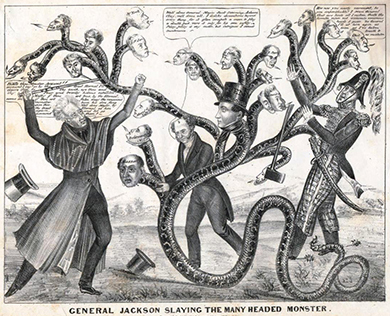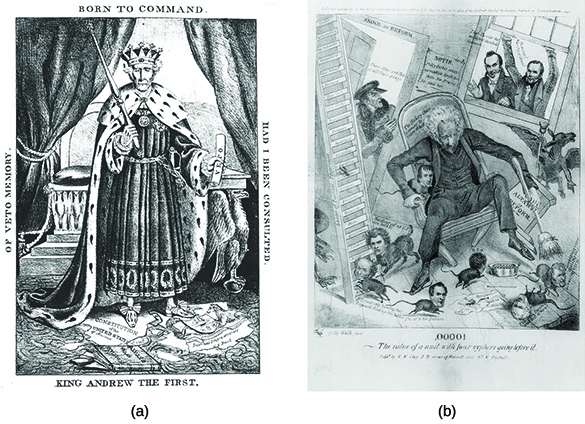| << Chapter < Page | Chapter >> Page > |
In the reelection campaign of 1832, Jackson’s opponents in Congress, including Henry Clay, hoped to use their support of the bank to their advantage. In January 1832, they pushed for legislation that would re-charter it, even though its charter was not scheduled to expire until 1836. When the bill for re-chartering passed and came to President Jackson, he used his executive authority to veto the measure.
The defeat of the Second Bank of the United States demonstrates Jackson’s ability to focus on the specific issues that aroused the democratic majority. Jackson understood people’s anger and distrust toward the bank, which stood as an emblem of special privilege and big government. He skillfully used that perception to his advantage, presenting the bank issue as a struggle of ordinary people against a rapacious elite class who cared nothing for the public and pursued only their own selfish ends. As Jackson portrayed it, his was a battle for small government and ordinary Americans. His stand against what bank opponents called the “ monster bank ” proved very popular, and the Democratic press lionized him for it ( [link] ). In the election of 1832, Jackson received nearly 53 percent of the popular vote against his opponent Henry Clay.

Jackson’s veto was only one part of the war on the “monster bank.” In 1833, the president removed the deposits from the national bank and placed them in state banks. Biddle, the bank’s director, retaliated by restricting loans to the state banks, resulting in a reduction of the money supply. The financial turmoil only increased when Jackson issued an executive order known as the Specie Circular, which required that western land sales be conducted using gold or silver only. Unfortunately, this policy proved a disaster when the Bank of England, the source of much of the hard currency borrowed by American businesses, dramatically cut back on loans to the United States. Without the flow of hard currency from England, American depositors drained the gold and silver from their own domestic banks, making hard currency scarce. Adding to the economic distress of the late 1830s, cotton prices plummeted, contributing to a financial crisis called the Panic of 1837. This economic panic would prove politically useful for Jackson’s opponents in the coming years and Van Buren, elected president in 1836, would pay the price for Jackson’s hard-currency preferences.
Jackson’s veto of the bank and his Specie Circular helped galvanize opposition forces into a new political party, the Whigs , a faction that began to form in 1834. The name was significant; opponents of Jackson saw him as exercising tyrannical power, so they chose the name Whig after the eighteenth-century political party that resisted the monarchical power of King George III. One political cartoon dubbed the president “King Andrew the First” and displayed Jackson standing on the Constitution, which has been ripped to shreds ( [link] ).

Whigs championed an active federal government committed to internal improvements, including a national bank. They made their first national appearance in the presidential election of 1836, a contest that pitted Jackson’s handpicked successor, Martin Van Buren, against a field of several Whig candidates. Indeed, the large field of Whig candidates indicated the new party’s lack of organization compared to the Democrats. This helped Van Buren, who carried the day in the Electoral College. As the effects of the Panic of 1837 continued to be felt for years afterward, the Whig press pinned the blame for the economic crisis on Van Buren and the Democrats.
Explore a Library of Congress collection of 1830s political cartoons from the pages of Harper’s Weekly to learn more about how Andrew Jackson was viewed by the public in that era.
Andrew Jackson’s election in 1832 signaled the rise of the Democratic Party and a new style of American politics. Jackson understood the views of the majority, and he skillfully used the popular will to his advantage. He adroitly navigated through the Nullification Crisis and made headlines with what his supporters viewed as his righteous war against the bastion of money, power, and entrenched insider interests, the Second Bank of the United States. His actions, however, stimulated opponents to fashion an opposition party, the Whigs.

Notification Switch
Would you like to follow the 'U.s. history' conversation and receive update notifications?